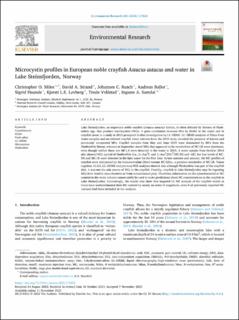| dc.description.abstract | Lake Steinsfjorden, an important noble crayfish (Astacus astacus) habitat, is often affected by blooms of Planktothrix spp. that produce microcystins (MCs). A poor correlation between MCs by ELISA in the water and in crayfish tissue in a study in 2015 prompted further investigation by LC–HRMS. LC–HRMS analyses of filters from water samples and on selected crayfish tissue extracts from the 2015 study revealed the presence of known and previously unreported MCs. Crayfish samples from May and June 2015 were dominated by MCs from the Planktothrix bloom, whereas in September novel MCs that appeared to be metabolites of MC-LR were dominant, even though neither these nor MC-LR were detected in the water in 2015. A water sample from October 2016 also showed MCs typical of Planktothrix (i.e., [d-Asp3]- and [d-Asp3,Dhb7]MC-RR and -LR), but low levels of MC-RR and MC-LR were detected in the lake water for the first time. In late summer and autumn, the MC profiles of crayfish were dominated by the homonorvaline (Hnv) variant MC-LHnv, a putative metabolite of MC-LR. Taken together, ELISA, LC–HRMS and previous PCR analyses showed that although Planktothrix was part of the crayfish diet, it was not the sole source of MCs in the crayfish. Possibly, crayfish in Lake Steinsfjorden may be ingesting MCs from benthic cyanobacteria or from contaminated prey. Therefore, information on the cyanobacterial or MC content in the water column cannot safely be used to make predictions about MC concentrations in the crayfish in Lake Steinsfjorden. Interestingly, the results also show that targeted LC–MS analysis of the crayfish would at times have underestimated their MC content by nearly an order of magnitude, even if all previously reported MC variants had been included in the analysis. | en_US |

